What Is Amherst’s Top Spending Priority? The Answer May Surprise You
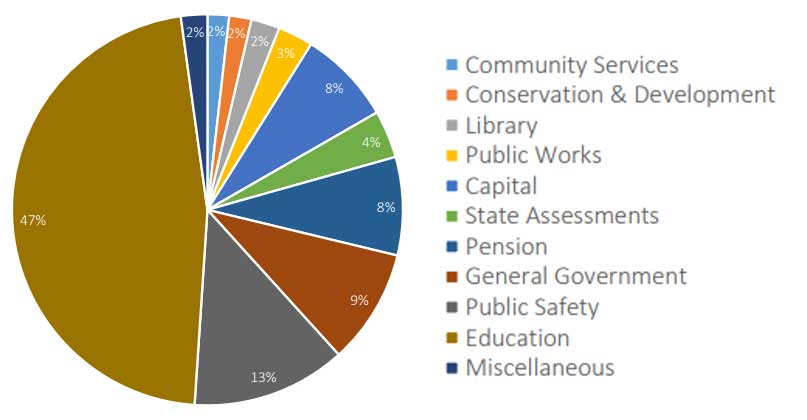
Pie Chart Representing Proposed Town of Amherst FY24 Budget. Source Amherstma.gov
What is Amherst government’s highest spending priority?
Many will be quick to answer “education.” Amherst is home to three prestigious institutions of higher ed, the excellence of our public schools has long been a source of pride and a reason many people choose to live here, and, like most Massachusetts communities, education is by far the largest category of spending in our annual budget.
However, a dive into Massachusetts Department of Revenue (DOR) statistics reveals that, compared to municipalities across the state, education is not our most generous spending target.
Consider Amherst’s investment in public education.
The DOR’s Division of Local Services (DLS) publishes a dashboard showing trends in general fund revenues and expenditures for major government spending categories across all 351 communities in the Commonwealth. The DLS describes the general fund as the overall account which cities and towns maintain and use to pay for government services.
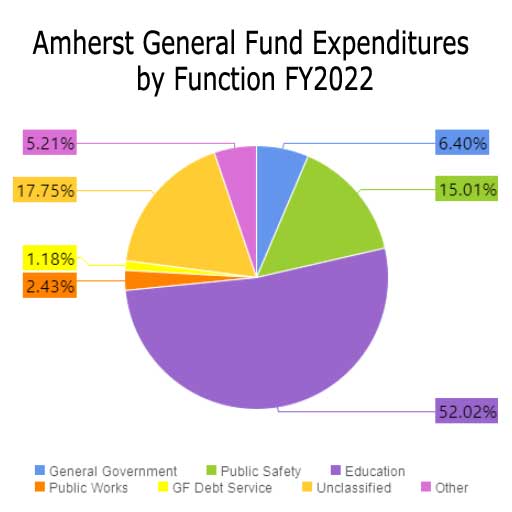
In FY2022 Amherst spent $40.9 million on public education out of total general fund expenditures of $78.6 million , or 52.0%. On average, Massachusetts municipalities used 49.9% of general fund expenditures on education, putting Amherst a little over the average in education spending. Amherst ranks 160th in the state for percentage of general fund expenditures allocated to education.
Out of the 20 communities in Hampshire County, Amherst ranks 9th in the percentage of expenses used for education. Huntington is highest in the county, at 67.9%, while Middlefield is lowest, directing 27.7% of its general fund expenses to education. The average education expenditure for all Hampshire County cities and towns is 49.0%. It is interesting to note that the two Franklin County towns in the Amherst-Pelham regional school district, Leverett and Shutesbury, apportion 60.7% and 62.1% of their general fund expenditures to education, respectively.
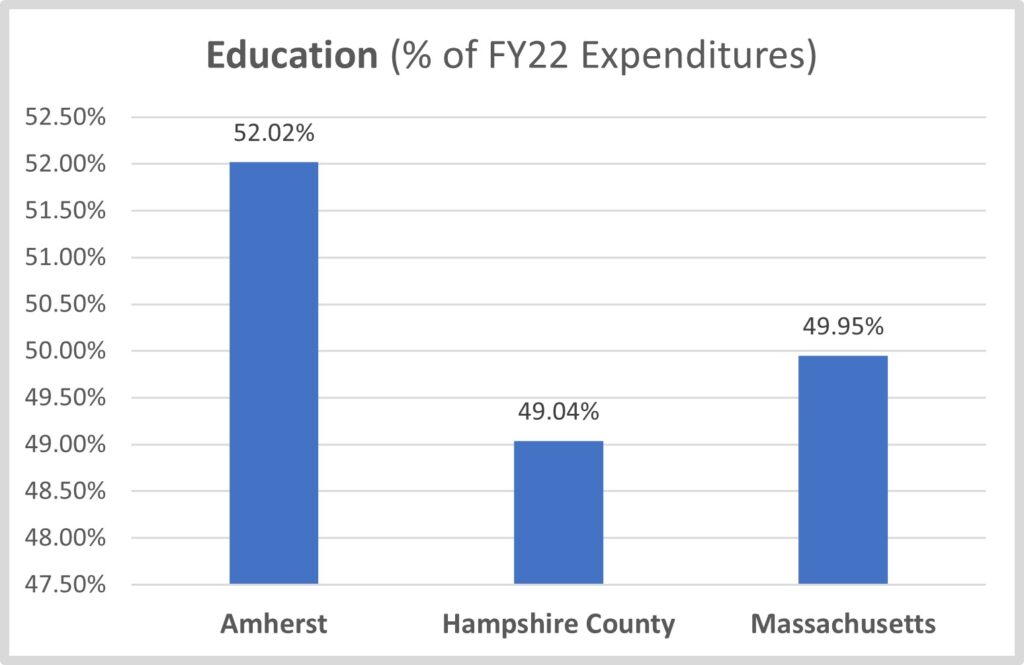
So, Amherst is moderately though not extremely generous in its appropriation of funds for education. There is another government service, however, where Amherst ranks close to the top in the state for percentage of funds expended. That is public library spending.
The DLS reports that Amherst’s $2.1 million Jones Library appropriation represents 2.65% of its general fund expenses for FY22. These funds are used to pay the salaries of Library staff. Amherst ranks fourth in the state for percentage spent on libraries, after Wenham on the North Shore, and the Martha’s Vineyard towns of West Tisbury and Chilmark.
Amherst library spending percentage is more than double the averages for Hampshire County (1.12%) and Massachusetts (1.11%) as shown in the chart below.
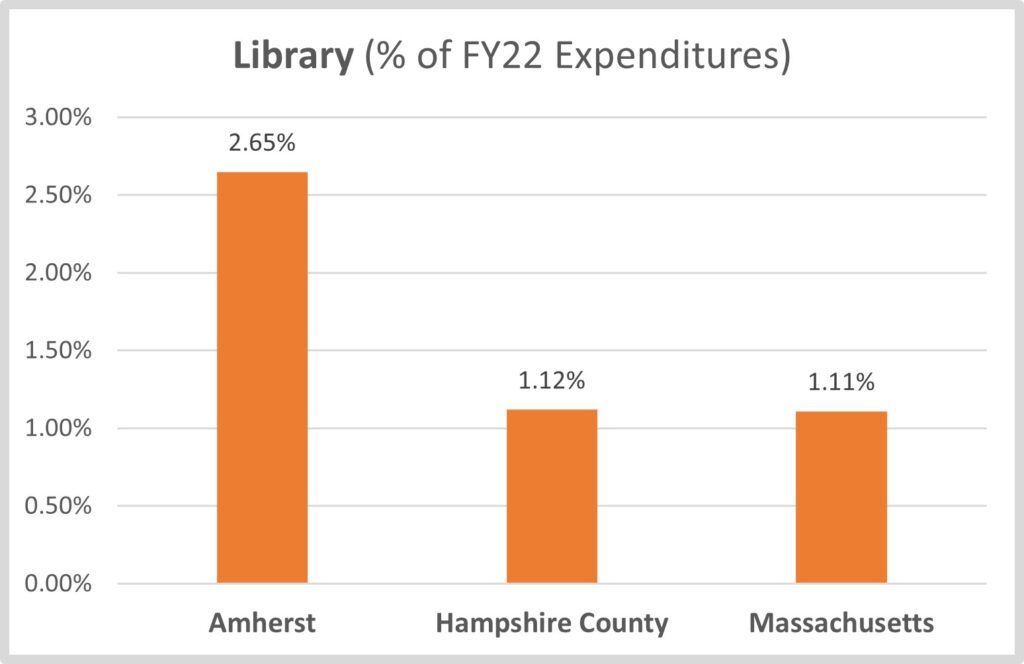
Note that the expense figures for both education and libraries do not include costs for building projects funded through borrowing. The DLS dashboard maintains a separate category for debt service.
Finally, the data shows that Amherst has been exceptional in the lack of spending it devotes to Public Works (roads and sidewalks). In FY22 Amherst dedicated 2.43% of its general fund expenses to Public Works – less than its library expenditure – which places it 6th from the bottom relative to all 351 Massachusetts communities. The state average is 8.47% of general fund expenditures spent on Public Works. In Hampshire County the average is 11.23% and Amherst ranks dead last.
May is the start of the review period for the FY24 budget recommended by the Town Manager. Throughout the month the Finance Committee will be meeting twice a week, on Tuesdays from 5:30-7:30pm and on Fridays from 1-4pm, and working on a version of the budget to be recommended to the Town Council for final approval. All meetings will be posted on the Town Calendar and will feature a public comment period.
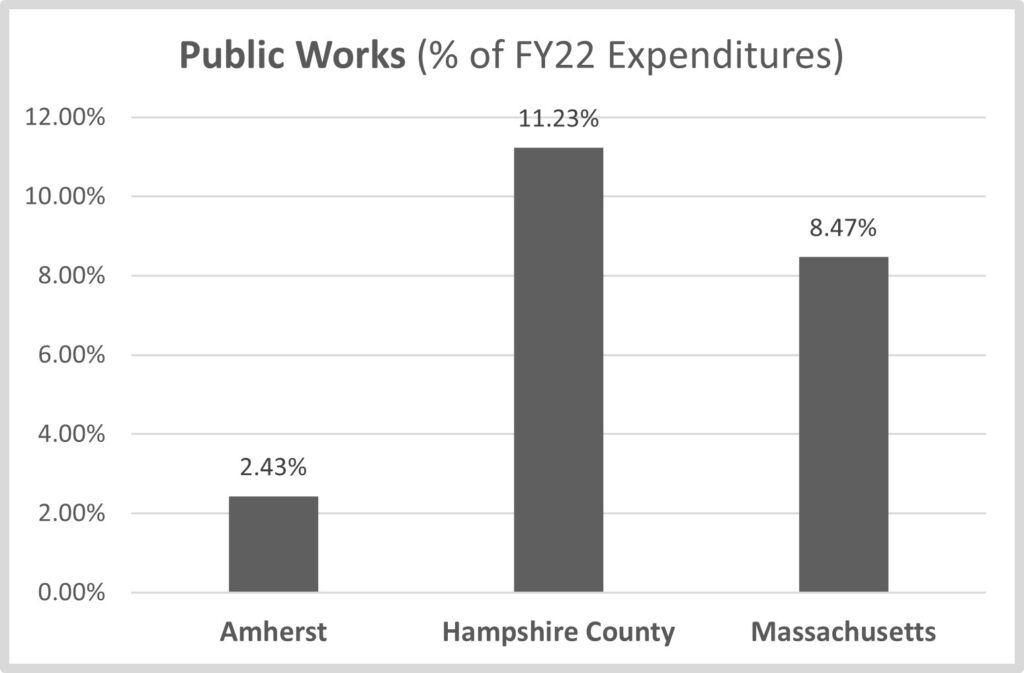

I missed this piece when it first appeared, and think this form of analysis is a very insightful way of revealing a community’s priorities.
Even more remarkable is the fact that the beneficiary of this public largesse is an independent organization, incorporated as a Massachusetts non-profit, with separate sources of funding.
One might wonder whether the large discrepancy between Amherst’s library expenditures and those in other communities reflects the failure of the staff and Trustees of this non-profit corporation to properly manage its endowment and operating budget.
On the other hand, while the even greater discrepancy in public works expenditures may be more shocking — and more believable given the state of our roadways — perhaps that can be explained in part by the way we account for some of the public works functions, particularly through the sewer and water funds?
Jeff, to further Rob’s point, are we saying that we have too many libraries in this town? I mean if the Trustees were to properly manage their growing expenses, surely downsizing the number of buildings would be one of their first thoughts.
On another note, I realize that you are pointing out our general lack of investment in public works, how does this compare historically? Is this a new thing? I seem to remember when we first moved to the area some 9 years ago, the state of the roads was a big topic of discussion then. What was the reasoning then? How can it be shifted now?
Marcus Smith
Good question, Marcus. I would say no, the branch libraries are not a significant part of the Town’s annual general fund expenditure on the library. As town-owned buildings, the North Amherst and Munson Libraries are maintained outside the library budget. The Jones Trustees report using the Town contribution purely to pay staff salaries.
The soon-to-be-unveiled North Amherst Library renovation was done with almost no burden to the library and taxpayer, thanks to the generosity of an anonymous donor.
At a Board of Trustees Meeting President Austin Sarat and Director Sharon Sharry expressed displeasure that the Town contribution does not cover all Library salaries, requiring the Jones to dip into its other sources of revenue. Sarat pledged to complain to Town leaders about this.
Regarding Amherst’s Public Works spending, it appears that, with the exception of 2005 when DPW spending exceeded $2 million, Amherst’s investment in Public Works has been consistently low. This chart, which includes a comparison to Library spending, was pulled from Dept. of Revenue data.
Year DPW Spending Library Spending2003 $1,619,699 $1,332,745
2004 $1,495,156 $1,384,465
2005 $2,001,584 $1,415,166
2006 $1,532,632 $1,461,526
2007 $1,464,605 $1,568,346
2008 $1,605,854 $1,563,260
2009 $1,497,107 $1,596,471
2010 $1,393,402 $1,467,093
2011 $1,700,297 $1,509,622
2012 $1,540,889 $1,665,666
2013 $1,476,136 $1,690,788
2014 $1,767,158 $1,741,512
2015 $1,859,625 $1,788,532
2016 $1,684,967 $1,833,245
2017 $1,932,373 $1,879,077
2018 $1,899,295 $1,926,054
2019 $1,923,807 $1,993,466
2020 $1,835,911 $2,043,302
2021 $1,887,444 $2,043,302
2022 $1,912,289 $2,086,027
You are not alone in thinking that Amherst needs to prioritize road improvement. I’d urge you to communicate your concerns to the Town Council, and if they don’t listen, cast your vote in November for candidates who will.
Jeff, the construction of the North Amherst library is at little to no cost, but the library does not run for free. How many other towns of a similar size in MA, have the same number of libraries that Amherst does?
As for the DPW costs, what was the rational back in the early 2000’s for this lack of priority and why has it continued? This isn’s a new problem, obviously. Why are we treating it like it is?
Marcus Smith
Marcus, I don’t know what drove the setting of DPW spending in years past. Possibly is was limited by the amount of staff in the Public Works Dept. and what they could manage operating out of their 100-year-old headquarters.
I haven’t found stats on the communities in Mass. that have branch libraries, though the popular Lily Library in Florence comes to mind. My personal sense is that there is a general public appreciation for Amherst’s branch libraries. I would venture that the branches are viewed as more cost beneficial than the nearly $50 million demolition-renovation-expansion of the Jones Library.
But you raise a reasonable question. Above all I believe that Amherst’s spending priorities should be determined democratically by the residents, and not by the pet whims and political alliances of a handful of Town Councilors.